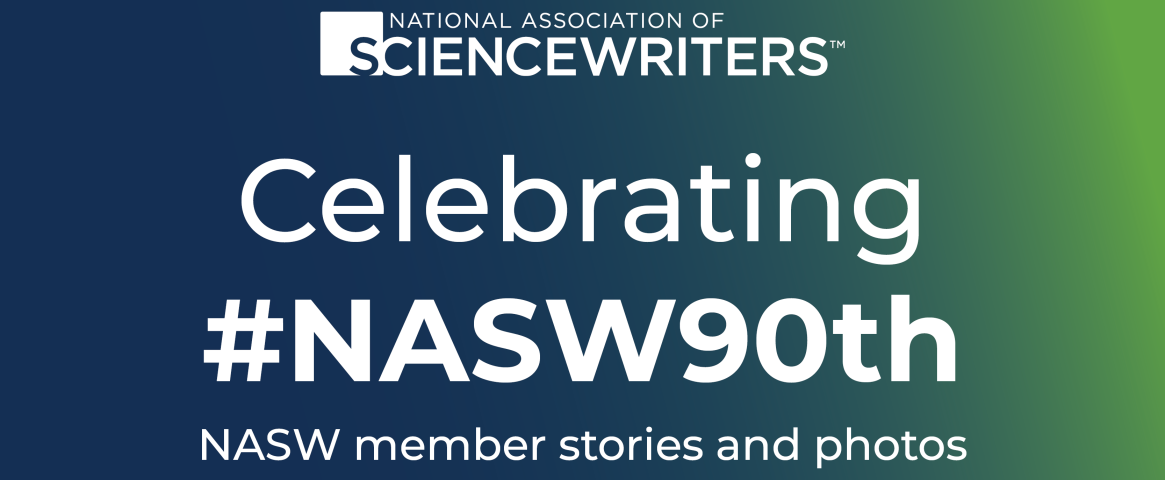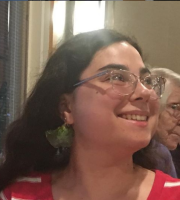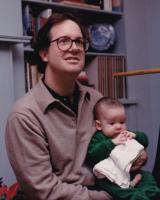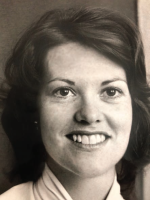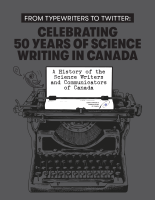Happy #NASW90th, everyone! The year 2024 marks the 90th anniversary of the founding of our National Association of Science Writers — and NASW members are sharing their stories and memories in celebration.
Read on below for the contributions so far from NASW members — then contribute your own words to our NASW 90th Anniversary Story + Photo Share project! Memories from your first NASW gathering? Friendships and mentors you gained through NASW? Moments in history where science writing made a difference? Your hopes for science writing in the next 90 years? We'd also love photos of NASW gatherings or photos of yourself on the job, in the field or at your desk. Help us commemorate this moment in NASW's history.
Stories have been edited for clarity and layout purposes. Follow more #NASW90th celebrations on Bluesky and on LinkedIn.
Decorating our 90th anniversary issue are photos curated by the Media Archaeology Lab (MAL) at the University of Colorado Boulder, depicting newsroom technology over the decades. We thank MAL for the use of their images (CC BY-NC 4.0) with a further donation to their campus fund. Visit MAL online at www.mediaarchaeologylab.com
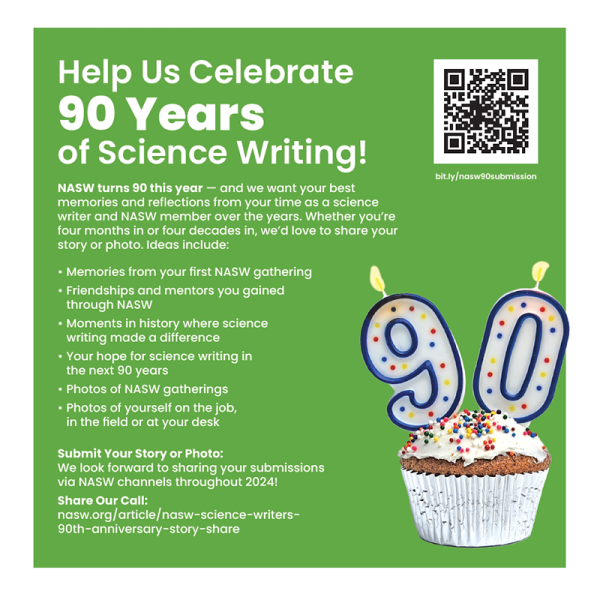 Early Support
Early Support
Attached is the I.D. photo I chose for my first NASW membership card, when I signed up in summer 2023 after college graduation.
In between then and winter 2024 — when I landed my first full-time job out of college — NASW gave me lots of support. Its 2023 virtual convention allowed me to meet countless new peers and mentors in the field, who were all very happy to give me advice on networking and job searching. And now I work at a science publishing company!
— Ariel Finkle (NASW member since 2023)
With the Tides
Earlier this year, 2024, during a time of financial hardship, I was able to renew my membership for free. I resolved to take advantage of all NASW has to offer, and to be its biggest cheerleader... I am really grateful to NASW for helping me upskill in my journalism endeavors and, in a time when the economy is still unstable, provides free resources for me to become an even better writer.
The best part is that my financial situation is slowly improving, and I have learned new skills — and I look forward to giving back to NASW and helping people learn about ways they can use NASW to stay connected to the science writing world, now that I am past that bleak economic time.
— Sheeva Azma (NASW member since 2020)
Glory Days
No one has cut their teeth on science writing at a better time than I, in the 1960’s, when science fiction was becoming fact, seemingly by the day. Watson and Crick had received the Nobel Prize for their DNA work. Quasars had astronomers agog. Astronauts were booming into space. The word processor and laser arrived. And newspapers were in their Cretaceous Period, flourishing but on the brink of apocalypse. In 1959, I started as a copy boy at the New York Daily Mirror, running lunches and stripping the racing wires; if I could fight my way through reporters clustered around the wire machines, hoping their horses had come in. In those days, big-city street reporters were largely a blue-collar bunch, working and playing hard. I made my way through weeklies, driving the truck that delivered papers overnight for one, and finally landed at a daily, The Bergen Evening Record in Hackensack, N.J.
There I successfully begged my editors to let me cover my two main interests, law enforcement/crime and science. I landed assignments such as interviewing mob boss Tommy Eboli sitting with his family at his kitchen table; and reporting on research by the many big pharma companies in the coverage area. Best of all, I was able to tie both interests together covering a major case of industrial espionage targeting drug companies.
My big break came when the spanking-new Council for the Advancement of Science writing assigned me a mentor, [former NASW president and inaugural CASW president] Earl Ubell, then of the New York Herald Tribune, later WCBS-TV (where I later ended up as “The Animal Man” on a kid’s program; that’s another story). I have spent the rest of my life in fruitless quest to write science with the flair and skill that Ubell possessed. The CASW program propelled me into a Sloan-Rockefeller Fellowship at Columbia and I was off to the races. I was an editor in the science division of Scholastic Magazines and then Curator of Publications for the New York Zoological Society at the Bronx Zoo (now called the Wildlife Conservation Society). In 1971, I left my office with a fireplace at the Bronx Zoo and went full time freelance. Again I was able to meld my two interests, becoming versed in covering international wildlife crime. Early on, though I forget exactly when, I joined NASW. If my memory is correct, I took a brief hiatus, and then rejoined. Attending meetings as a newbie thrust me into the science writing universe — invaluable.
I am turning 86, so may wax nostalgic, but I am convinced I reported and wrote in the shadow of science writing giants. Besides Ubell, I rubbed elbows with Walter (of the We Are Not Alone fame) Sullivan of The New York Times and [former NASW president] Alton Blakeslee of the Associated Press. I do not think we will see their like again. They were all old-school journalists who turned to science writing when science news grabbed banner headlines.
Each of them had his own approach to handling science. I remember Sullivan and Ubell writing about the same time on quasars. Sullivan’s lead was informative but technical, suited to an informed audience. Perhaps reflecting the difference between the Gray Lady and the Trib, Ubell began (and I hope I am remembering it exactly): “A fire burns on the fringes of the universe.” Almost every time I strive to make science interesting, those words emerge from the past and form in my mind.
— Ed Ricciuti (NASW member since 1960's)
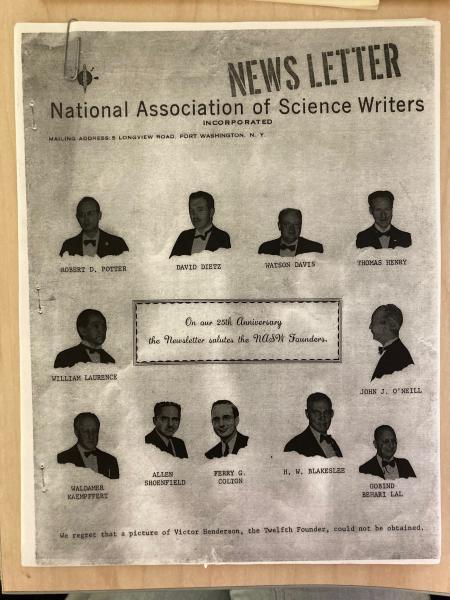 Cover of the September 1959 edition of the NASW newsletter featuring the founding members of NASW, including Howard W. Blakeslee, father of Alton Blakeslee. (Credit: Sarah Nightingale)
Cover of the September 1959 edition of the NASW newsletter featuring the founding members of NASW, including Howard W. Blakeslee, father of Alton Blakeslee. (Credit: Sarah Nightingale)
A Room Full of Storytellers
I joined NASW in 2008, but didn't attend my first ScienceWriters meeting until 2010, when it was held in New Haven, Conn. I can remember walking into the opening night reception and being overwhelmed. I found it incredibly intimidating — a sea of unfamiliar faces, interspersed every so often by faces I knew only from their byline photos. But I had spent a decade as a reporter before becoming a PIO, and if there is one thing reporters (even former reporters) are good at, it is walking up to people you don't know and asking them questions. So that's what I did.
It quickly became clear that I had found my community. The people in that room came from many different backgrounds, but there were certain common threads that tied them all together. This was a group of people who was interested in how things work and why they work that way. Everyone thought it was important to help people gain a deeper understanding of the world around us. Everyone agreed that journalism was not only valuable but important. That may all sound a little high-minded, but what it boiled down to was that this was a group of people who were not boring. The conversations were fascinating. This was a room full of storytellers. This was fun.
Over the course of that meeting it also became clear that these were people who took science writing seriously. They wanted to get better at their craft. They wanted to get better at finding story ideas. At finding the right people to talk to. At writing. At editing. At everything. These were people who wanted to keep learning and growing. They were also people who were willing to share what they knew, so that others could also learn and grow. How great is that?
Over time many of those unfamiliar faces became acquaintances, then friends. Making my membership in NASW not only professionally valuable, but personally rewarding.
I've learned a lot from the various sessions and panels I've attended through NASW — whether in person or online. And I've learned even more through conversations I've had with people I met through NASW. I certainly wouldn't be the science writer I am without NASW, for whatever that's worth. And I wouldn't be the person I am without the relationships I've made there. And that is worth a great deal.
— Matt Shipman (NASW member since 2008)
Rescue Mission
Checking my membership card, I see that I joined NASW in 1987. I had been a member of New England Science Writers (NESW) for several years. Our fearless leader, Jim Cornell, told us that we should really join the national organization, and he would sponsor us if we were interested. That must be how I got through the door.
Around that time I got a very interesting project through an announcement at a NESW meeting. A local research institute, Health Effects Institute (HEI) in Cambridge, needed a hand with a multi-author book being published jointly with the National Academy Press in Washington. I signed on, and it soon developed that what they really needed was dynamite to pry the manuscripts loose from a too-enthusiastic copyeditor working in another city. That person's goal was perfection, but HEI just wanted to get the book out. This was in the era when everything was done on hardcopy, so there was only one master version.
A subterfuge was involved that I now forget, but I managed to rescue the chapters. Then I served as production editor, commissioning the art, speccing the design, and coordinating with National Academy Press. The result, Air Pollution, the Automobile, and Public Health (1988), is nowadays posted online: https://www.ncbi.nlm.nih.gov/books/NBK218150/
So my first job as a NASW member was not exactly science writing, but it was definitely science.
— Richard Maurer (NASW member since 1987)
How Cool All This Was
2017 was my first-ever Science Writers conference in San Francisco, and I was full of nervous energy. A few months before, I'd quit my full-time job to become a freelance journalist. As I stood in one of the grand halls of the California Academy of Sciences, a new acquaintance struck up a conversation with me, then asked, "Do you want to see something cool?"
As science writers, we all know the answer is always yes. We slipped away from the main party and into an unmarked door off one of the stairwells, where a museum researcher led us through a maze of hallways and into a room filled with shelves. I had no idea what I'd said yes to until someone started taking jars off shelves and passing them around; they were fish specimens collected from around the world, and we were getting a behind-the-scenes look at the museum's extensive ichthyology collection. Before I could even process how cool this all was, the acrid smell of formaldehyde filled the room. The researcher had brought out a rare specimen: a 3-foot-long coelacanth, a fish scientists thought was long extinct until some were found in the 1930s, near South Africa.
This unexpected delight set the tone for my NASW experience — I know that if I'm in the presence of other members, I'm sure to learn something new!
— Jane C. Hu (NASW member since 2015)
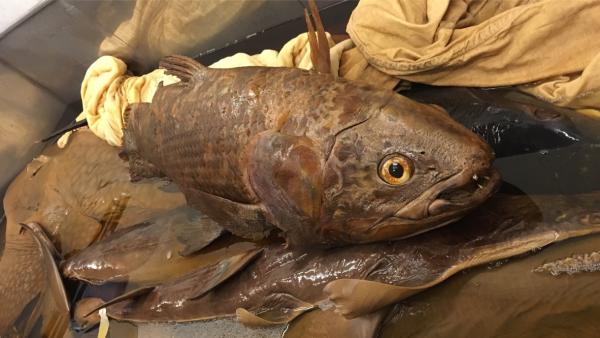 A specimen of Latimeria chalumnae, the West Indian Ocean coelacanth, at the California Academy of Sciences (Credit: Jane C. Hu)
A specimen of Latimeria chalumnae, the West Indian Ocean coelacanth, at the California Academy of Sciences (Credit: Jane C. Hu)
Early Adopter
I joined NASW in the early 1990s, and I think my first NASW meeting was in 1998 in Philadelphia when NASW annual meetings were held alongside AAAS Annual Meetings. I was among a number of people covering it for New Scientist, so I spent much of my time attending sessions, writing in my room, talking with my colleagues, and dealing with computer problems. I attended some NASW events, and remember Joel Shurkin talking about his adventures in writing a biography of William Shockley. I'm sure I met fellow science writers whom I had known only from their printed (in those days, still the main way of publishing) words, but I can't remember who.
The details are faded because I was preoccupied with writing for news for New Scientist. Peter Aldhous, then the news editor, was also at the meeting, and I had recently bought a used PowerBook 5300 so I could file stories at the meeting. It was my first laptop, and the thing weighed 5.9 pounds. It came with a dial-up modem that I had to attach to the phone in my room. It was clunky compared to the desktop Mac in my home office that I had connected to a phone line dedicated to sending and receiving data and transmitting and receiving faxes.
What was driving me nuts was a breakdown in computer communication. I was an early adopter of the Internet and email, and had an account at one of the first Internet Service Providers, Software Tool and Die. In theory, I should have been able to dash off my stories and fire them off to the editors who were also at the meeting, but no matter how many times I tried, I couldn't send anything through to — or receive anything from — any of the editors. I finally stored my stories on a floppy disk and carried it to them, and the news did go through, but I didn't have much time to socialize. When I got home, I called Software Tool and Die, and they told me they had been hit with a deluge of spam, so they had blocked all email from the United Kingdom. I explained how much of a problem they had caused, and they later apologized. Meanwhile, I had to find another Internet service.
I joined the NASW Freelance Committee about 20 years ago, when full-time freelancing was less common than it is in 2024, and many of my of my friendships in NASW are with fellow FreeCom members. Others came from editors and writers I met at the few NASW meetings I attended in person, but I don't travel much. For many years I only travelled if my expenses were paid, because we didn't have money to spare, but it become a personal choice; I don't like traveling.
I have had the good fortune to cover stories that were important for policy and for important to our understanding of life, technology and our planet. I wrote the first book on Reagan's "Star Wars" project, which became a part of the debate over missile defense. I started covering climate change for New Scientist in the 1980s and have continued tracking climate as it has become vital for the planet, and now cover the technology being developed to reduce carbon emissions and climate change. I also covered the discovery of the asteroid impact that killed the dinosaurs, which was a revolution in geology and paleontology, and I was the first (by a day) to break the discovery of feathered dinosaurs, which proved that birds are dinosaurs.
I have little to say about mentors in NASW because I joined after earning my living from writing for a couple of decades after being mentored by Howard Rausch, the editor who hired me to write for Laser Focus magazine, where I worked full time for seven years.
— Jeff Hecht (NASW member since 1991)
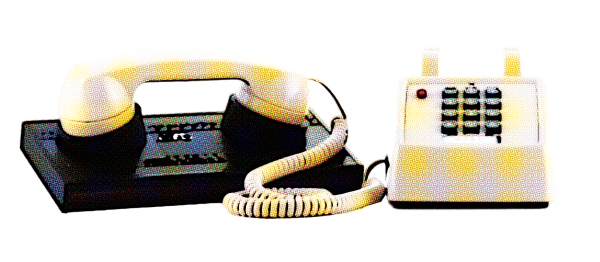
A Community of Peers
For the July 10, 1992 edition of the Dallas Business Journal, I did a feature article about the new technology entering the restaurant industry. The lead stated, "Technology has entered the dining room... Instead of running back to the kitchen counter and yelling out an order, many servers now enter customer requests directly into a restaurant's computer systems."
Imagine that! As a science reporter for industry publications, my work has allowed me to be eye witness to history. I am now able to look back and marvel at how far we have advanced.
Almost a decade later, at the 2000 Battery Power Conference in San Diego, my article for Advanced Battery Technology Magazine features another prescient look into the future. The conference chair led the discussion with the announcement of the "....newest 'Bluetooth' Personal Area Network,' the latest IEEE 801.11 'Facility Based Network,' and the 3G Cellular Standard.' I type this sentence now, 24 years later, using my Bluetooth enabled mouse, and thinking nothing of it.
In fact, the lead to that report starts with a question by a panelist:
"So, my question to the room is: what next? What comes after lithium ion?"
That question has still not been answered 24 years later.
When I eventually learned about and joined the National Association of Science Writers, it was a relief to finally have a place to go to share these experiences and have fellowship. The other sales engineers at the battery companies I was working for were not interested in discussing writing for publication. At writers' groups, I was usually the only person who was writing about technology, rather than novels.
At NASW, I found a community of peers.
— Jo'el Roth (NASW member since 2000)
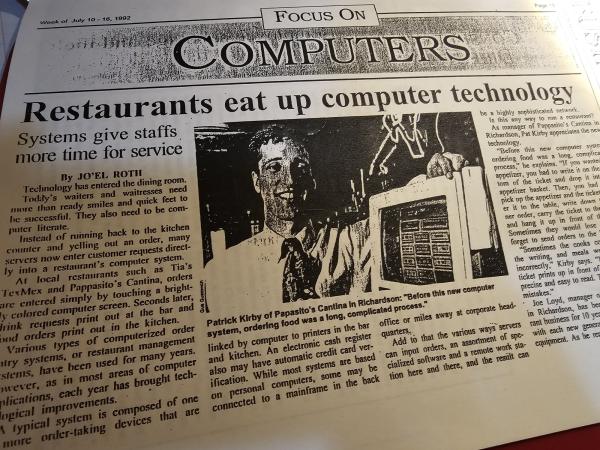 Jo'el's article in the Dallas Business Journal. (Credit: Jo'el Roth)
Jo'el's article in the Dallas Business Journal. (Credit: Jo'el Roth)
The Next Generation
For me, science writing has come full circle. I started medical writing in 1984, got my science journalism masters from NYU in 1990, and joined NASW circa 1992. I have been freelancing as a science writer since 1999. Quite gratifying considering I didn't even know science writing existed when I was an undergrad!
What has been even more gratifying is that both of my kids have followed in my footsteps. My oldest, Quinn Foster, writes about aerospace engineering for an international tech corporation. My daughter, Nina Foster, is an environmental writer who was awarded one of this year's NASW Diversity Fellowships to support her summer writing internship with the National Park Service at Acadia in Maine.
Science writing made it easier for me to be a working single parent to them. I could not be happier with my choice of career!
— Rosie Foster (NASW member since 1992)
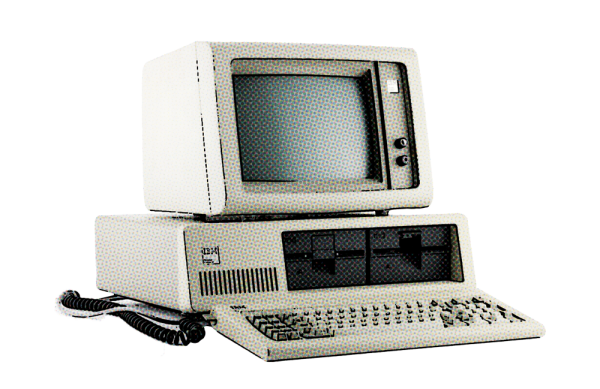
The Pursuit of Unexpected Stories
I’ve been a member of NASW since 2009, but my connection with it goes back at least two years before that, when I joined [the D.C. regional group], DCSWA, and learned firsthand the benefits of a science-writing community. With DCSWA, I enjoyed lively tours of Rock Creek Park and its geological and human history, and visits to Virginia vineyards where we learned about terroir.
I have gained so much from conversations with other NASW members and the support from the organization. That included a career development grant that allowed me to go and interview researchers about a new generation of renewable energy. And I’ve had the pleasure of supporting younger writers in their bids to join NASW and have seen their successes.
Fifteen years ago on a field trip with the Society of Environmental Journalists conference in Madison, Wisconsin, we visited the shack of Aldo Leopold, the pioneer of conservation and a land ethic. It was fascinating to visit by lamplight his raw-boned shrine to the study of nature, reading and writing. I found it moving to be in that space, surrounded by other writers with a similar curiosity.
Years later, I find myself making a podcast about Leopold and other writers of that period, called The People's Recorder. One episode features Leopold at a pivotal juncture in the 1930s when he was between jobs. Around that time, he contributed an essay on "Conservation" to the WPA Guide to Wisconsin. This was over a decade before his landmark book, A Sand County Almanac. His depiction in that essay of Wisconsin’s destruction of its native forests, for a lay audience, helped him find his way toward his true writing voice. I spoke with Leopold's biographer, Curt Meine, who traced that time in Leopold's evolution as a writer. He helped connect the dots from Leopold to the environmental movement and his influence in the creation of Earth Day.
I found it very meaningful to develop that episode, to discover Leopold's name in WPA guide's front matter and pursue the connections and context with his biographer, all while recalling that visit to his shack years ago, and the late sunlight as we left.
It has also been satisfying over the years to engage in my own pursuit of unexpected stories, connecting people and the processes of science and culture, and mentoring younger science writers. My hope is that when we mark NASW’s centennial in 10 years, our impact will be even more fully appreciated in the public conversation.
— David Taylor (NASW member since 2009)
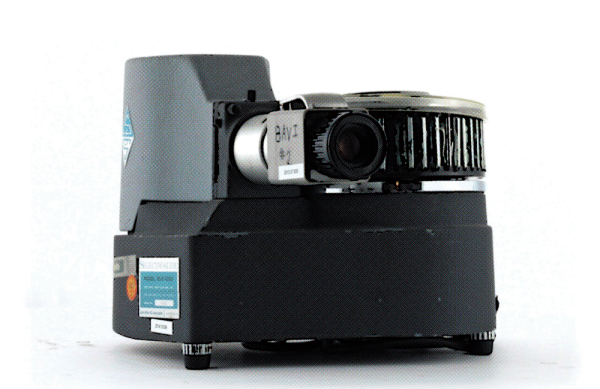
That Conversation in New York, or How I Won the Lottery (Sort of) and Made NASW Rich
In the late Autumn of 2001, Jonathan Tasini, the victorious plaintiff in the landmark case of Tasini v. New York Times, and head of the National Writers Union (NWU), put out a call for representatives of writers organizations to meet at his office in New York to explore how together we could take advantage of the recent decision affirming that freelance writer had rights in their works in the digital world just as we had long enjoyed in the world of paper and print. The invitation came to NASW’s general address and our then-executive director, Diane McGurgan, sent it to me, as the board member chairing the NASW Freelance Committee. I decided to accept the invitation, thinking that NASW needed to keep our freelance members (of whom I had long been one) up to date on how to protect ourselves in the confusing new digital scene. The board concurred and authorized my train fare. (Given NASW’s skimpy funding at the time, which depended almost entirely on dues, I planned to sleep over with friends). None of us had any idea that, though nothing would come of Tasini’s confab, this decision would utterly transform NASW.
Those who can remember NASW before 2002 know that it was a much different organization from what it is now. Programs that today’s members view as central to NASW’s work — travel, career, diversity, and Idea grants; money to support conference workshops, contest prizes, special projects such as website revisions and more — not only didn’t exist, but were totally undreamed of. They only came into being some years later because of a short, completely unexpected, conversation in the NWU conference room in lower Manhattan that would unlock the millions of dollars that NASW has spent on those items over the past 22 years and, we hope, will continue to spend for many years to come.
I had no idea of any of this as I rode Amtrak north from Washington and then joined a dozen or more other organizational representatives at Tasini’s conference table. We next sat through a rather indecisive meeting. I knew some of those present from writers community activities. But when we rose to get coffee during a break in the discussion, a woman I didn’t know approached me. She introduced herself as Marianne Shock. Then she asked what struck me as an odd question: How many members does NASW have? About 1,500, I answered.
Then came the question that would change everything: “Why don’t you belong to the Authors Coalition?” “What’s the Authors Coalition?” I asked in total ignorance.
It was, she explained to my utter astonishment, a partnership of American writers organizations that distributed money collected in Europe and elsewhere from fees paid for photocopying the work of American writers. Many countries, she continued, recognize the right of authors to receive payment when their works are copied in libraries, schools, copy shops and elsewhere. These countries collect fees from the owners of copy machines and distribute them individually to the creators of the copied works. But the agencies making these collections and distributions, known as Reproduction Rights Organizations, generally had no way of identifying individual Americans to receive the funds due to them under this principle because the United States does neither recognizes this right nor tracks whose works are copied. These foreign agencies have therefore decided, as a substitute for paying particular Americans, to distribute the funds to American writers organizations that promise to use them for the professional benefit and advancement of their members. The group of organizations that have banded together to form the Authors Coalition of America is the principal distributor of overseas RRO money in the United States.
As I digested these astonishing facts, Marianne asked another surprising question: Does NASW have at least 500 members who are authors of published articles, books or other writings?
Many more than that, I answered. All of our 1500 regular members are published authors.
Well then, she said, NASW may well be eligible to join the Coalition. She added that she couldn’t predict how much money we might receive, because that would depend on the kind and number of works our members had published, but all member groups are guaranteed an annual minimum of $5,000.
Now I was completely thunderstruck. A guaranteed five thousand dollars a year! NASW could certainly use that.
My amazement continued as Marianne explained that member organizations had to be national — check! — nonprofit — check! — and dedicated to the professional advancement of their members — check! They could not discriminate on the basis of location, race, religion, sex, etc. Another check! And they could not derive more than a quarter of their income from sources other than dues, conferences and sale of publications. Check again! Okay, then, Marianne said, you’re probably eligible. Why don’t you apply?
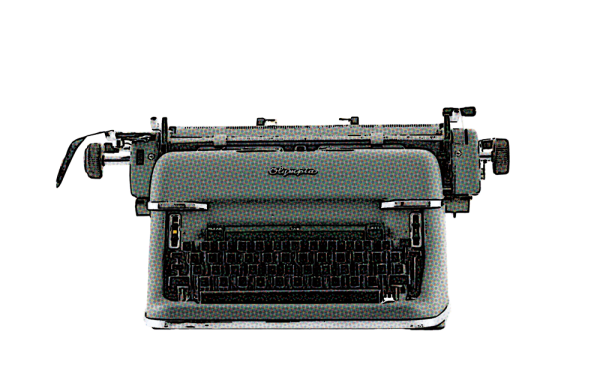
As soon as I could, I wrote an email to my fellow board members recounting this flabbergasting conversation and asking for permission to explore applying. Naturally, being skeptical journalists, they concluded that I was insane or deluded or that this had to be some sort of a scam. But Marianne seemed on the level, I countered, and the revered Jonathan Tasini had welcomed her to his meeting along with all the others. He certainly wouldn’t have invited a known fraud. And I did a bit of looking around and it all seemed legit. So the board gave me permission to look into applying. Years later, then-President Richard Harris of NPR told me that he thought I was nuts, but I was so enthusiastic and letting me follow my head seemed harmless.
I quickly contacted Marianne at her office in suburban Detroit and asked how to proceed. The process was simple. I was to write a letter describing NASW’s membership and work, explaining how we met the Coalition’s requirements, and including a copy of our basic document, which for us is called the constitution. I dispatched the application immediately.
Back came a disappointing answer. Though NASW met nearly all the criteria, its constitution did not specify that advancing the interests of its members was a principal purpose. Rather, it stated the purpose as “foster[ing] the dissemination of accurate information regarding science and technology through all media normally devoted to informing the public; and … the interpretation of science and its meaning to society, in keeping with the highest standards of journalism.” I wrote back that NASW’s activities, including the conference, our publications, awards, Job Bank, and more indicated NASW’s interest is its members’ professional welfare.
No dice, Marianne responded. The organization’s fundamental document had to state that purpose explicitly. So that meant amending the constitution. Again, the board was bemused, to say the least, but I told them I was going ahead. We were not going to miss the chance for a free $5,000 a year for lack of an amendment. Fortunately, in those days, proposing an amendment was easy, requiring only twenty members’ signatures plus a favorable vote by the membership at large.
This of course, meant explaining the bizarre-seeming information about free money to 1,500 skeptical writers. Many people did not understand at first, and the title Reproduction Rights Organization didn’t help. But I got the necessary signatures without much trouble, some from the listservs and the rest at a meeting that D.C. Science Writers Association (DCSWA) happened to hold, I remember, at the United States Botanic Garden near the Capitol. There, among the palm trees and orchids, I collected the remainder of the needed signatures from people I knew, many probably humoring me.
So the proposal to add “In addition, this organization shall foster and promote the professional interests of science writers” to the NASW constitution’s Statement of Purpose went before the membership. After more explanation to those perplexed by why anyone wanted to give us money, over 900 NASWers voted in favor. For some reason I can’t understand, a few voted against.
So, with our constitution now apparently meeting Coalition criteria, I sent the amended version to Marianne. Back came the happy news that we were accepted for membership. But, of course, nothing is as easy as it looks, and we learned that, in order to determine how much money we were entitled to each year, we would have to survey the membership annually, with each person indicating on an abstruse form the types of works they had authored during their careers. This was the once-infamous Genre Survey, which members now answer as a matter of course when they join or renew their membership. This is necessary because the donating organizations determine payments based on the kind of work that is being copied, with a certain portion for each of a number of specific categories. Each country has its own system, and it’s all too complicated to explain, but the Coalition tracks the incoming loot and divides it according to the rules among the receiving organizations. Detailed figures on each group’s survey and resulting receipts are available each year.
Getting people to understand what this bizarre-seeming survey was and why it was important again took a while, and, to add to the complications, in those days the survey was done, like most everything else, on paper. This produced a 3-ream pile of individual sheets, each with a number of items checked. Every one of those check marks meant dollars for NASW, and each therefore had to be specifically tabulated. This created a huge but vitally important job for Diane McGurgan, who received all this paper and had the responsibility of translating it into the specific numbers for print academic books, print journalistic articles, online poetry and all the other categories now so familiar to NASWers. The original survey papers that would back up our claims also had to be preserved. Diane solved these problems by dedicating a portion of her garage in Hedgesville, W.V., to boxes of completed surveys and by recruiting her husband, Buddy, and a neighbor, whom she paid, to do that actual count. Meanwhile, Diane and I also had to attend conference calls, first monthly and later quarterly, of the Coalition partners. Though at first we found these incomprehensibly technical, we gradually learned an exotic vocabulary and set of issues formerly completely unknown to either of us.
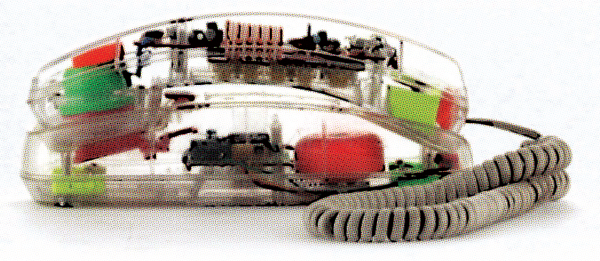
So every year, once the totals from the surveys were known, I would send them to Marianne in a notarized affidavit. And then the money began to flow. And flow. And flow. The amount was unpredictable and varied some each year, but generally increased as people saw that this was, indeed, not a scam and that every check mark on every survey really did add a bit to our income. And we saw that $5,000 was a tiny fraction of what would be coming as the totals mounted into tens and hundreds of thousands of dollars for NASW to spend. I vividly remember one day fairly early in our membership when I learned that a certain country was liquidating a large escrow fund it had been holding and NASW’s share would approach a quarter million dollars.
Now I knew how it feels to win the lottery, I told the board as I shared this literally awesome news. People happily thanked me for the money, as they generally did when I reported new payments, but I once again explained, as I regularly had to, that the money was not mine and I just did the paperwork. Regardless of this, the board awarded me the second Diane McGurgan Service Award (the first one rightly went to Diane herself) for my persistence in pursuing the application process to the end and then shepherding our Coalition membership.
All these riches also imposed a heavy responsibility on NASW to safeguard and use them wisely. The board established the principle that we would only budget and spend money we had already received, as we could not predict how much would arrive in any given year. It also gradually determined the kind of services and efforts we would spend it on, including grants of various kinds. Over time this list has expanded to include a number of other services and functions as well, including support for the conference and much more.
Eventually the membership and renewal process went online, and the genre survey did too, and now people barely think of it was they click through the required forms. That means that the Coalition funds are now fully integrated into NASW’s functioning, as they should be, because they have been earned by the work of every person who completes the survey each year and, thanks the structure of the NASW membership forms, that is now every member. Over the years, others took over the responsibility for running this system, and making it even easier. I served as NASW’s ACA liaison for the first dozen years, backed up by Diane and then Tinsley as substitute representatives at the meetings. For years now, the automated membership system has reported the genre totals, doing away with the stacks of paper and the arduous, meticulous hand count of thousands of pencil checks by Buddy and the neighbor.
And now, hardly anybody thinks of the Coalition and the funds it provides as the miracle we once considered it to be. I still do, however, because I know how close we came to never having it. And I think of all the good it has done, all the people who have been able to expand their professional knowledge and horizons and all the many worthy projects (The Open Notebook via our Idea Grants, to name just one at random) that have had a chance to flourish because of the support it made possible.
For me, the memory of the chance conversation that brightened the dark aftermath of 9/11 is indelible — as is, I hope, all the good that has and will continue to come of it.
I don’t expect I’ll ever again win the lottery, but I’ll never forget how it feels.
— Beryl Lieff Benderly (NASW member since 1984)
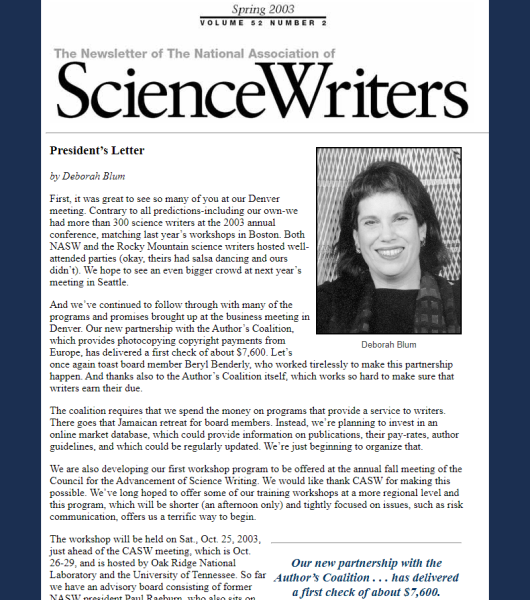 A Spring 2003 edition of ScienceWriters with then-president Deborah Blum commending Beryl Benderly, who has served as NASW board member, board treasurer, committee chair, and ACA liaison over her years as an NASW member. (Credit: NASW)
A Spring 2003 edition of ScienceWriters with then-president Deborah Blum commending Beryl Benderly, who has served as NASW board member, board treasurer, committee chair, and ACA liaison over her years as an NASW member. (Credit: NASW)
The Canadian Connection
A Special Contribution from the Science Writers and Communicators of Canada (SWCC)
Back in the day, the NASW had a notable membership in Canada. That’s because science writers there didn’t have their own organization, and thus turned to south of the border and became active members of the NASW. But all that changed in in the 1960s as the Canadian members politely and bureaucratically created their own, separate organization.
The details are provided in these excerpts from the new book From Typewriters to Twitter: Celebrating 50 Years of Science Writing in Canada published in 2023 by what is now called the Science Writers and Communicators of Canada (SWCC).
— Pippa Wysong (NASW member since 2024), SWCC 50th anniversary book project editor
In the beginning: The Canadian Science Writers’ Association (CSWA) did not exist in name until 1971. But the key players in its creation were active members of the National Association of Science Writers (NASW) — an American organization established in 1934. In June 1961, then NASW president Victor Cohn created a committee to address the needs of members of the NASW who lived and worked in Canada. Chaired by Leonard Bertin, and including members such as Fred Poland, David Spurgeon, and Ben Rose, the "NASW—Canadian Committee" was formally established at a meeting at The Queen Elizabeth hotel in Montreal in August 1961. The NASW executive extended formal recognition to the Canadian Committee in December 1961, renaming it the "Canadian Section of the NASW’"
In August 1962, during the second annual meeting, again at The Queen Elizabeth, the Canadian Committee formally adopted the name Canadian Section of the NASW and had powers to elect its own officers. Leonard Bertin was re-elected as chair. Over the next few years, under the guidance of several different leaders and the board of directors, the Canadian Section held its annual meetings in conjunction with the annual conference of the Royal College of Physicians and Surgeons of Canada (RCPSC), usually held in January or February. The RCPSC conference was a great source of story ideas for the science writers who attended.
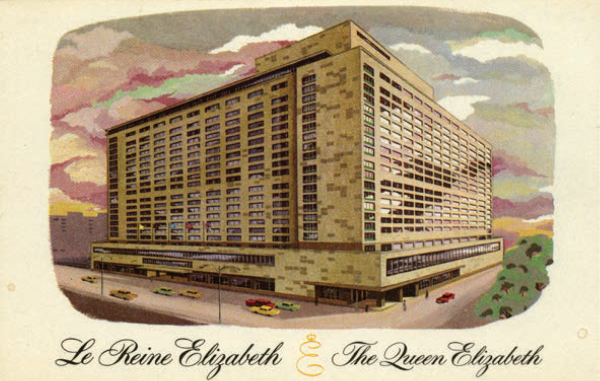 The Queen Elizabeth Hotel as depicted in a postcard, 1962 (Image courtesy of Archives de la Ville de Montréal, file P500Y-2_001-P002)
The Queen Elizabeth Hotel as depicted in a postcard, 1962 (Image courtesy of Archives de la Ville de Montréal, file P500Y-2_001-P002)
Urges for independence: Despite the mere handful of science writers belonging to the Canadian Section, members wanted a Canadian association that was independent of the NASW. At the Section’s tenth annual meeting held in Montreal on Jan. 22, 1970, Section members adopted a resolution to pursue the formation of a Canadian association of science journalists. At a subsequent meeting on May 28, 1970 held in the former Maclean-Hunter Publishing Co. boardroom in Toronto, a motion was passed to prepare a draft constitution by August 1970. (Maclean-Hunter was a leading Canadian publishing company founded in 1887 that was acquired by Rogers Communications Inc. in 1994). On the evening of Oct. 15, 1970, the draft constitution was revised and adopted, and the Canadian Science Writers’ Association (CSWA) was officially born.
The founding meeting, 1971: Tucked away in the boardroom of the Science Council of Canada in Ottawa, the founding meeting for the CSWA was chaired by Earl Damude, editor of The Medical Post. Dr. Omond M. Solandt, chair of the Science Council of Canada, offered the use of the boardroom for the meeting. Present at the meeting were Leonard Bertin, University of Toronto science editor; David Spurgeon, science reporter for The Globe and Mail and editor of Science Forum; Fred Poland, the Montreal Star; Peter Calamai, Southam News Service, Ottawa; Jeff Carruthers, The Ottawa Journal; David Smithers, the Ottawa Citizen; Heather Carswell, The Medical Post (Montreal); Ian J.S. Moore, MD of Canada (Montreal); Ken Kelly, Canadian Press science editor (Ottawa); and Mack Laing, University of Waterloo journalism professor.
Excerpts from the 1962 annual meeting minutes of the National Association of Science Writers (NASW—Canadian Section) held August 22:"We now have 10 active members. They are Dave Valker, David Spurgeon, Ben Rose, Roland Prevost, Fred Poland, Ernie Myers, Herb Lampert, Rae Corelli, Brian Cahill, Leonard Bertin. In addition, we have four associate members: Doug Veston, Mel Thistle, Ron Kenyon, Duncan Cameron. At least three others are interested in membership: Joan Hollobon, Marc Enri Cote, Jack Livingstone.
“Our Canadian group was formally established at a meeting in this hotel (The Queen Elizabeth, Montreal) last year at this time, originally as the ‘National Association of Science Writers, Canadian Committee’. I would like to remind you of a slight change in the status of our group, vis-a-vis the parent body, since that meeting, as a result of actions taken by the executive of NASW.
“At the December 1961 meeting, the executive formally recognized the existence of the Canadian Section of NASW, and suggested that this name replace that of ‘Canadian Committee’ which had previously been adopted by Canadian members at their Montreal meeting. The document stated:
“To clarify the present situation, then, there are now two Canadian organizations within NASW: (l) The "Canadian Section", formed by Canadian members and comprising all of them, for the purpose of dealing with exclusively Canadian business, and (2) The "Canadian Affairs Committee” of the NASW executive, responsible to the president of NASW, and dealing with Canadian affairs affecting the parent body.”
Leonard Bertin, science writer and war prisoner: Leonard Bertin was the first president of the CSWA’s precursor association, the Canada Section of the National Association of Science Writers. He was born in London, England, his father a church vicar who worked with the poor in London’s East End throughout the Great Depression. He studied natural sciences at the University of Cambridge in England before World War II. After the war, he completed his degree in modern and mediaeval languages. During World War II, Leonard served on horseback on the Northwest Frontier of India in a battery of mule-pack ‘screw guns’. Promoted to major, he led an anti-tank regiment in Iraq, Syria, Palestine and the Western Desert. He was captured at the Battle of Tobruk in Libya in 1942, but escaped from a train en route to Nazi Germany, was recaptured three and a half months later and sent to an officers’ POW camp for the duration of the war.According to his son, Oliver Bertin, his dad learned reporting from other prisoners. They held lectures in the POW camp to help each other rebuild their careers when the war finally ended. He teamed up with some former newspapermen who used clandestine radios to research and publish an internal camp newspaper that was so good their Italian captors dropped by to catch up on the news. Post war, he became Rome correspondent and later the first science editor of the Daily Telegraph. “He had a very interesting time as a foreign correspondent, covering atomic bomb blasts at Woomera and Christmas Island,” Oliver said. His father watched the Bikini Atoll atomic blast tests from a nearby navy ship. In 1957, Leonard emigrated to Canada as science editor of the Financial Post, followed by the Toronto Star and then science editor and News Bureau head at the University of Toronto. A decade later, he moved to Kingston, Ont., as editorial page editor of the Kingston Whig-Standard.
He authored six popular books about science including Atom Harvest (1955), a book that uncovered secret atomic research in the U.K.; The Boys' Book of Modern Scientific Wonders and Inventions (1957); Nuclear Winter (1986) and others. His book Target 2067: Canada’s Second Century (1968), mused about what Canada might be like in the year 2067. He portrayed a world with 15 billion people (a hundred million in Ontario!), moving sidewalks, extensive fish farms, jobs on Mars, and apartment buildings over 200 stories high. He was known for his belief in the immense potential good science could offer, but in later years recognized the challenges.
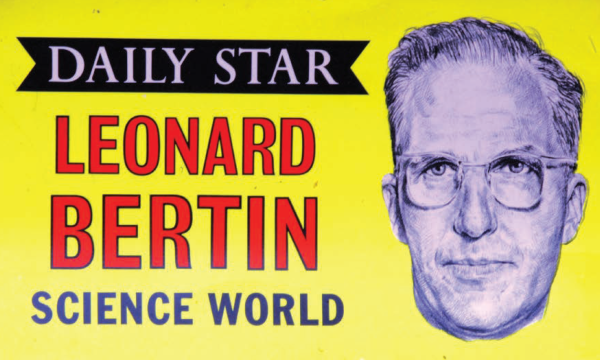 Poster promoting Leonard Bertin appearing on the side of newspaper boxes. Bertin, the Toronto Star’s science writer, was often stopped on the street by readers who shook his hand and complimented his journalism, recounted his son Oliver to the SWCC. “This was most embarrassing for his teenage kids”. (Photo courtesy of SWCC/Oliver Bertin)
Poster promoting Leonard Bertin appearing on the side of newspaper boxes. Bertin, the Toronto Star’s science writer, was often stopped on the street by readers who shook his hand and complimented his journalism, recounted his son Oliver to the SWCC. “This was most embarrassing for his teenage kids”. (Photo courtesy of SWCC/Oliver Bertin)
Contribute your #NASW90th stories and photos at: https://www.nasw.org/article/nasw-science-writers-90th-anniversary-story-share
Founded in 1934 with a mission to fight for the free flow of science news, NASW is an organization of ~3,000 professional journalists, authors, editors, producers, public information officers, students and people who write and produce material intended to inform the public about science, health, engineering, and technology. To learn more, visit www.nasw.org and follow NASW on LinkedIn and Bluesky.
